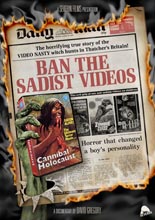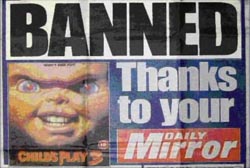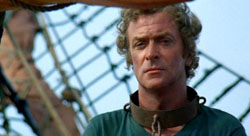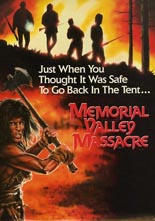
 As someone who is against censorship in any and all forms, I found the two-part documentary Ban the Sadist Videos! both fascinating and infuriating. Written and directed by David Gregory (Plague Town) for the venerable cult-DVD label Blue Underground, the piece examines the “video nasty” scandal of the early-’80s United Kingdom.
As someone who is against censorship in any and all forms, I found the two-part documentary Ban the Sadist Videos! both fascinating and infuriating. Written and directed by David Gregory (Plague Town) for the venerable cult-DVD label Blue Underground, the piece examines the “video nasty” scandal of the early-’80s United Kingdom.
At a time when unemployment was arguably the UK’s greatest problem — resulting in riots and overall societal unrest — the media began a moral crusade to point a shaking, accusatory finger at horror films. Specifically, blame was placed among 72 so-called “video nasties,” including such gory works as Lucio Fulci’s Zombie, Abel Ferrara’s The Driller Killer, Sam Raimi’s The Evil Dead, Jess Franco’s Bloody Moon, just about anything with “cannibal” in the title, and many other flicks that enjoy a home in my collection. (Another is the more obscure House on Straw Hill, on whose Blu-ray package this feature-length doc currently can be found.)
 While I find Snuff to hold no artistic value, Faces of Death as nothing but irredeemable trash, and SS Experiment Love Camp to be abhorrent in its misogyny, none of them should be banned — then, now or ever. Not in agreement was activist Mary Whitehouse, a humorless biddy who led the movement to prosecute dealers who dare rented these VHS tapes in their uncut form; cuts suggested were completely subjective.
While I find Snuff to hold no artistic value, Faces of Death as nothing but irredeemable trash, and SS Experiment Love Camp to be abhorrent in its misogyny, none of them should be banned — then, now or ever. Not in agreement was activist Mary Whitehouse, a humorless biddy who led the movement to prosecute dealers who dare rented these VHS tapes in their uncut form; cuts suggested were completely subjective.
One Sadist commentator compares the circus to the Salem witch trails, which, in hindsight, isn’t an exaggeration. While England no longer has to worry about complying with Parliament’s Video Recordings Act 1984, we sadly still have to deal with politicians who ignore tackling true social problems in order to waste time and money legislating their personal beliefs onto everyone else. People starve and the economy crumbles, and yet we’re arguing over whether gays should marry and if evolution should be taught in schools. To me, that’s far more offensive and damaging to a populace than fake blood squirting from a fake torso after a fake beheading in a fake story. —Rod Lott


 One of the precious few genre films made by Japan’s Shochiku production studio,
One of the precious few genre films made by Japan’s Shochiku production studio, 






